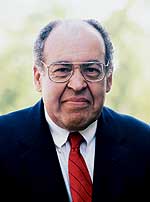James Nabrit ’52
Law Man
By H. Jay Burns
Literally and figuratively, lawyers like James Nabrit III ’52 charted a path for the Civil Rights movement. In the 1960s, for example, the city of Birmingham, Ala., was using various ordinances to stifle black activism.

In one instance, a local preacher, Fred Shuttlesworth, was sentenced to 180 days of hard labor for refusing to move from where he stood in front of a department store. The case made it to the U.S. Supreme Court, and in Shuttlesworth v. Birmingham, a case Nabrit argued and won, the court blasted the city, saying its interpretation of the ordinance “bears the hallmark of a police state.”
In 1965, Nabrit helped blaze a more literal route for the movement. On “Bloody Sunday” — March 7, 1965 — voting-rights marchers on the outskirts of Selma, Ala., were beaten by state police. A federal court ordered protection for the marchers, but demanded a detailed march plan.
Overnight, Nabrit and fellow lawyers with the NAACP Legal Defense Fund, working with Martin Luther King Jr.’s Southern Christian Leadership Conference, drew up the now historic march route from Selma to Montgomery. “There was a comical element to it,” Nabrit admitted in an interview with Washington Lawyer in 2001. “The plan contained the names of various churchyards and farms where the marchers proposed to camp. The New York Times said it read like a biblical trek through the wilderness. I later joked that it was my only biblical writing.”
Nabrit’s late father, James Jr., had gained fame in the 1950s by arguing a desegregation case that went to the Supreme Court along with the landmark Brown v. Board of Education. He also served as Howard University’s president and received an honorary degree from Bates in 1963.
Then it was the son’s turn. At Bates, Nabrit remembers kindness from the late John Donovan ’42, then a young political science professor. “I grew taking his classes,” he says. “I grew in understanding the world.” Nabrit did his Bates senior thesis on litigation against segregation, and he got help from a family friend: Thurgood Marshall, then director-counsel of the Legal Defense Fund and later a Supreme Court justice. “I don’t claim my senior thesis was any great document,” Nabrit laughs. “My father knew about it, and Thurgood knew about it.”
During his 34-year law career, Nabrit won nine of 12 cases he argued before the Supreme Court. He retired in 1989 as the second-ranking LDF staffer and today lives in Silver Spring, Md., with his wife, Jackie. He is active with LDF as secretary of its board.
Despite batting .750 before the highest court, Nabrit downplays a lawyer’s influence at that late stage of the game. “Most justices already have a tentative view of how they’re going to vote,” he says. What they want is clarification and discussion, not fiery rhetoric. “They want someone to help them think through the problem.”
Among Nabrit’s favorite cases is a little-known appellate victory in 1966. One winter, Baltimore police set out on a manhunt for two liquor store robbers who’d killed a cop. Carrying submachine guns, tear gas, but no search warrants, they conducted 300 raids, mostly in the black community, based on anonymous tips. The man Nabrit represented in the case, a post office worker, had gone to bed after watching the New Year’s Day football games. “He woke up at 2 a.m. with a shotgun in his face,” Nabrit says.
Nabrit and his client didn’t seek monetary damages, but rather a guarantee against similar raids ever occurring again. The appellate court came through, calling the raids “the most flagrant invasions of privacy ever to come under the scrutiny of a federal court.”
For Nabrit, the case typified the best of lawyering: teaming with ordinary people willing to stand up to extraordinary circumstances. Indeed, the larger Civil Rights movement required not only intellectual leadership at the top, but also, he once said, “the passion and courage of many people who were willing to put their lives on the line.”